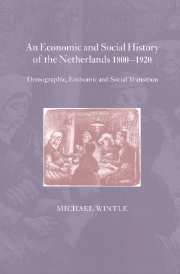 An Economic and Social History of the Netherlands, 1800–1920
An Economic and Social History of the Netherlands, 1800–1920 Book contents
- Frontmatter
- Contents
- List of plates
- List of figures
- List of tables
- Acknowledgements
- General introduction
- Part I Demography, and the health of the nation
- 1 Demographic indicators
- 2 The condition of the people: public health, diet and nutrition
- Part II Economic Transition
- Part III Social transition: state, society, individual and nation
- General conclusion
- Bibliography
- Index
1 - Demographic indicators
Published online by Cambridge University Press: 13 August 2009
- Frontmatter
- Contents
- List of plates
- List of figures
- List of tables
- Acknowledgements
- General introduction
- Part I Demography, and the health of the nation
- 1 Demographic indicators
- 2 The condition of the people: public health, diet and nutrition
- Part II Economic Transition
- Part III Social transition: state, society, individual and nation
- General conclusion
- Bibliography
- Index
Summary
Population increase and vital statistics
One of the most eloquent indicators of the state of an economy is the physical well-being of its population. The demographic history of the Dutch in the modern period has some distinctive characteristics, while remaining clearly rooted in the mainstream pattern of European development. The European population increased approximately fourfold between 1750 and 1950, from 144 million to 574 million. There was considerable variance in the rate of increase across the regions of Europe, and the Netherlands tended to fit into the pattern of faster growth which characterized some of the northern European nations like the United Kingdom, Scandinavia, northern Germany and the Low Countries. Between the beginning of the nineteenth century and the outbreak of the Second World War, the world population is estimated to have grown by a factor of 2.4, the European by a factor of 2.9, while the Dutch managed to expand their numbers by a factor of no less than 4.4.
Indeed, a whole string of more subtle demographic indicators than the gross population increase show the Netherlands to have been something of a demographic maverick: not only did it possess one of the highest growth rates, but it also has had some of the highest birth rates and the lowest death rates in the world, and in the twentieth century its life expectancy has also been among the highest. All this has meant that the Netherlands is now the most densely populated country in the OECD area.
- Type
- Chapter
- Information
- An Economic and Social History of the Netherlands, 1800–1920Demographic, Economic and Social Transition, pp. 7 - 39Publisher: Cambridge University PressPrint publication year: 2000
